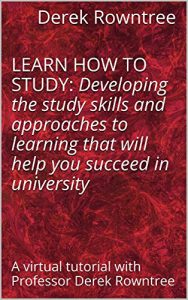Please WELCOME back Professor Derek Rowntree's LEARN HOW TO STUDY, now in its 6th edition. First published 45 years ago, it has since helped more than a MILLION readers around the world in a variety of languages.
Back in 1970 it was the ORIGINAL — the first book about studying to offer readers the friendly, tutorial style (incorporating 'interactive' activities with feedback) that has since become such a feature of Open University teaching materials and has been adopted by numerous other authors of books for students.
Since 1988, however, Professor Rowntree was too busy pioneering elearning courses at the Open University to have time to update his book. Consequently it soon seemed to him to be not relevant enough to the very courses he was developing, so he let it go out of print for the last ten years. Now, in his retirement, and many years richer in experience of student learning, he has at last found time to rewrite the book into the 21st century of learning.
LEARN HOW TO STUDY is not a collection of handy hints and quick fixes. Of course, it includes chapters on the critical reading of texts (in print and on screen), making notes, learning from seminars, lectures and new media, writing essays, tackling exams successfully, and so on — but presented in a way that encourages students to become reflective and exploratory about their approaches to learning and choose for themselves which ways of studying best meet their purposes. Professor Rowntree suggests to students that the three things they need to do to succeed are as follows:
•to understand what they want out of learning and what other people (especially tutors) expect of them.
•to develop approaches that will enable them to acquire the kind of learning that will satisfy their tutors while also getting what they themselves want from the process.
•to convincingly demonstrate that learning in both formal and informal assessment situations.
And this ‘virtual tutorial’ aims to help readers succeed in these goals, despite the 'hidden curriculum' and the often conflicting pressures within their learning situation.
CONTENTS
0 About this book — Please read this FIRST
I The myths and realities of being a student
2 Studying and learning
3 Understanding your situation
4 Getting organized for learning
5 Developing a strategy for reading
6 The art of reading critically (1)
7 The art of reading critically (2)
8 Learning from listening
9 Making and using notes
10 Preparing academic essays (1)
11 Preparing academic essays (2)
12 Dealing with examinations
Final comments
References
Back in 1970 it was the ORIGINAL — the first book about studying to offer readers the friendly, tutorial style (incorporating 'interactive' activities with feedback) that has since become such a feature of Open University teaching materials and has been adopted by numerous other authors of books for students.
Since 1988, however, Professor Rowntree was too busy pioneering elearning courses at the Open University to have time to update his book. Consequently it soon seemed to him to be not relevant enough to the very courses he was developing, so he let it go out of print for the last ten years. Now, in his retirement, and many years richer in experience of student learning, he has at last found time to rewrite the book into the 21st century of learning.
LEARN HOW TO STUDY is not a collection of handy hints and quick fixes. Of course, it includes chapters on the critical reading of texts (in print and on screen), making notes, learning from seminars, lectures and new media, writing essays, tackling exams successfully, and so on — but presented in a way that encourages students to become reflective and exploratory about their approaches to learning and choose for themselves which ways of studying best meet their purposes. Professor Rowntree suggests to students that the three things they need to do to succeed are as follows:
•to understand what they want out of learning and what other people (especially tutors) expect of them.
•to develop approaches that will enable them to acquire the kind of learning that will satisfy their tutors while also getting what they themselves want from the process.
•to convincingly demonstrate that learning in both formal and informal assessment situations.
And this ‘virtual tutorial’ aims to help readers succeed in these goals, despite the 'hidden curriculum' and the often conflicting pressures within their learning situation.
CONTENTS
0 About this book — Please read this FIRST
I The myths and realities of being a student
2 Studying and learning
3 Understanding your situation
4 Getting organized for learning
5 Developing a strategy for reading
6 The art of reading critically (1)
7 The art of reading critically (2)
8 Learning from listening
9 Making and using notes
10 Preparing academic essays (1)
11 Preparing academic essays (2)
12 Dealing with examinations
Final comments
References






